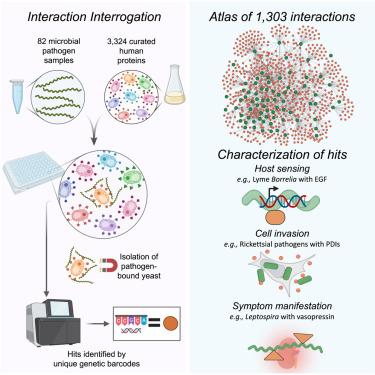Our official English website, www.x-mol.net, welcomes your
feedback! (Note: you will need to create a separate account there.)
An atlas of human vector-borne microbe interactions reveals pathogenicity mechanisms
Cell ( IF 45.5 ) Pub Date : 2024-06-13 , DOI: 10.1016/j.cell.2024.05.023 Thomas M Hart 1 , Nicole D Sonnert 2 , Xiaotian Tang 1 , Reetika Chaurasia 1 , Paige E Allen 3 , Jason R Hunt 3 , Curtis B Read 3 , Emily E Johnson 4 , Gunjan Arora 1 , Yile Dai 5 , Yingjun Cui 1 , Yu-Min Chuang 1 , Qian Yu 1 , M Sayeedur Rahman 6 , M Tays Mendes 6 , Agustin Rolandelli 6 , Pallavi Singh 1 , Abhai K Tripathi 7 , Choukri Ben Mamoun 8 , Melissa J Caimano 9 , Justin D Radolf 10 , Yi-Pin Lin 11 , Volker Fingerle 12 , Gabriele Margos 12 , Utpal Pal 13 , Raymond M Johnson 8 , Joao H F Pedra 6 , Abdu F Azad 6 , Jeanne Salje 14 , George Dimopoulos 7 , Joseph M Vinetz 15 , Jason A Carlyon 3 , Noah W Palm 5 , Erol Fikrig 1 , Aaron M Ring 16
Cell ( IF 45.5 ) Pub Date : 2024-06-13 , DOI: 10.1016/j.cell.2024.05.023 Thomas M Hart 1 , Nicole D Sonnert 2 , Xiaotian Tang 1 , Reetika Chaurasia 1 , Paige E Allen 3 , Jason R Hunt 3 , Curtis B Read 3 , Emily E Johnson 4 , Gunjan Arora 1 , Yile Dai 5 , Yingjun Cui 1 , Yu-Min Chuang 1 , Qian Yu 1 , M Sayeedur Rahman 6 , M Tays Mendes 6 , Agustin Rolandelli 6 , Pallavi Singh 1 , Abhai K Tripathi 7 , Choukri Ben Mamoun 8 , Melissa J Caimano 9 , Justin D Radolf 10 , Yi-Pin Lin 11 , Volker Fingerle 12 , Gabriele Margos 12 , Utpal Pal 13 , Raymond M Johnson 8 , Joao H F Pedra 6 , Abdu F Azad 6 , Jeanne Salje 14 , George Dimopoulos 7 , Joseph M Vinetz 15 , Jason A Carlyon 3 , Noah W Palm 5 , Erol Fikrig 1 , Aaron M Ring 16
Affiliation

|
Vector-borne diseases are a leading cause of death worldwide and pose a substantial unmet medical need. Pathogens binding to host extracellular proteins (the “exoproteome”) represents a crucial interface in the etiology of vector-borne disease. Here, we used bacterial selection to elucidate host-microbe interactions in high throughput (BASEHIT)—a technique enabling interrogation of microbial interactions with 3,324 human exoproteins—to profile the interactomes of 82 human-pathogen samples, including 30 strains of arthropod-borne pathogens and 8 strains of related non-vector-borne pathogens. The resulting atlas revealed 1,303 putative interactions, including hundreds of pairings with potential roles in pathogenesis, including cell invasion, tissue colonization, immune evasion, and host sensing. Subsequent functional investigations uncovered that Lyme disease spirochetes recognize epidermal growth factor as an environmental cue of transcriptional regulation and that conserved interactions between intracellular pathogens and thioredoxins facilitate cell invasion. In summary, this interactome atlas provides molecular-level insights into microbial pathogenesis and reveals potential host-directed targets for next-generation therapeutics.
中文翻译:

人类媒介微生物相互作用图谱揭示了致病机制
媒介传播疾病是全世界死亡的主要原因,并造成大量未得到满足的医疗需求。与宿主细胞外蛋白(“外蛋白组”)结合的病原体代表了媒介传播疾病病因学中的一个重要界面。在这里,我们使用细菌选择来阐明高通量宿主微生物相互作用 (BASEHIT)——一种能够询问微生物与 3,324 种人类外蛋白相互作用的技术——来分析 82 个人类病原体样本的相互作用组,其中包括 30 种节肢动物传播的病原体菌株以及 8 株相关的非媒介传播病原体。由此产生的图谱揭示了 1,303 个假定的相互作用,包括数百个在发病机制中具有潜在作用的配对,包括细胞入侵、组织定植、免疫逃避和宿主感知。随后的功能研究发现莱姆病螺旋体将表皮生长因子识别为转录调节的环境线索,并且细胞内病原体和硫氧还蛋白之间保守的相互作用促进细胞侵袭。总之,该相互作用组图谱提供了对微生物发病机制的分子水平见解,并揭示了下一代治疗的潜在宿主导向靶点。
更新日期:2024-06-13
中文翻译:

人类媒介微生物相互作用图谱揭示了致病机制
媒介传播疾病是全世界死亡的主要原因,并造成大量未得到满足的医疗需求。与宿主细胞外蛋白(“外蛋白组”)结合的病原体代表了媒介传播疾病病因学中的一个重要界面。在这里,我们使用细菌选择来阐明高通量宿主微生物相互作用 (BASEHIT)——一种能够询问微生物与 3,324 种人类外蛋白相互作用的技术——来分析 82 个人类病原体样本的相互作用组,其中包括 30 种节肢动物传播的病原体菌株以及 8 株相关的非媒介传播病原体。由此产生的图谱揭示了 1,303 个假定的相互作用,包括数百个在发病机制中具有潜在作用的配对,包括细胞入侵、组织定植、免疫逃避和宿主感知。随后的功能研究发现莱姆病螺旋体将表皮生长因子识别为转录调节的环境线索,并且细胞内病原体和硫氧还蛋白之间保守的相互作用促进细胞侵袭。总之,该相互作用组图谱提供了对微生物发病机制的分子水平见解,并揭示了下一代治疗的潜在宿主导向靶点。











































 京公网安备 11010802027423号
京公网安备 11010802027423号